Placing Ads and Promotions Online
As consumers spend more and more time on the Internet, many companies are shifting Online advertising more of their marketing dollars to online advertising to build their brands or to attract
Advertising that appears while consumers visitors to their Web sites. Online advertising is becoming a major medium. Last year, are surfing the Web, including display U.S. companies alone spent more than $21 billion on online advertising, up an incredible ads, search-related ads, online classifieds, 26 percent over the previous year, and more than they spent on newspaper, outdoor, or and other forms. radio advertising. Online ad spending will jump to more than $42 billion by 2011, rival ing or surpassing the amount spent on magazines and even television.53 Here, we discuss forms of online advertising and promotion and their future.
Forms of Online Advertising. The major forms of online advertising include display ads, search-related ads, and online classifieds. Online display ads might appear anywhere on an Internet user's screen. The most common form is banners, banner-shaped ads found at the top, bottom, left, right, or center of a Web page. For instance, a Web surfer looking up airline schedules or fares might encounter a flashing banner that screams, "Rent a car from Alamo and get up to two days free!" Clicking on the ad takes consumers to the Alamo Web site, where they can redeem the promotion.
Interstitials are online display ads that appear between screen changes on a Web site, especially while a new screen is loading. For example, visit www.marketwatch.com and you'll probably see a 10-second ad for Visa, Verizon, Dell, or another sponsor before the home page loads. Pop-ups are online ads that appear suddenly in a new window in front of the window being viewed. Such ads can multiply out of control, creating a major annoyance. As a result, Internet services and Web browser providers have developed applications that let users block most pop-ups. But not to worry. Many advertisers have now developed pop-unders, new windows that evade pop-up blockers by appearing behind the page you're viewing.
With the increase in broadband Internet access in American homes, many companies are developing exciting new rich media display ads, which incorporate animation, video, sound, and interactivity. Rich media ads attract and hold consumer attention better than traditional banner ads. They employ techniques such as float, fly, and snapback—animations that jump out and sail over the Web page before retreating to their original space.
But many rich media ads do more than create a little bit of jumping animation—they also create interactivity. Many of today's rich media ads provide consumers with product information, a brand experience, and even local or online buying options without taking them away from the site they are viewing. For example, to attract would-be commodity traders to its Web site, the Chicago Board of Trade runs a small rich media banner ad that explodes into a small site when the user's mouse rolls over it. The mouse-over site features a "tasting" of the site—free streaming quotes, sample research, and a virtual trading account, all of which would never fit into a traditional static ad.
Another hot growth area for online advertising is search-related ads (or contextual advertising), in which text-based ads and links appear alongside search engine results on sites such as Google and Yahoo!. For example, search Google for "HDTV." At the top and side of the resulting search list, you'll see inconspicuous ads for 10 or more advertisers, ranging from Circuit City, Best Buy, and Amazon.com to Dish Network, Nextag.com, and TigerDirect.com. Nearly all of Google's $16.59 billion in revenues come from ad sales. An advertiser buys search terms from the search site and pays only if consumers click through to its site. Search-related ads account for some 41 percent of all online advertising expenditures, more than any other category of online advertising.
Search ads can be an effective way to link consumers to other forms of online promotion. For example, Diageo uses keyword searches to lure Web surfers to sites promoting its Smirnoff Raw Tea and Ice products:
In the summer season of 2006, Diageo wanted to create brand awareness and engagement for its two brands, Smirnoff Ice and Smirnoff Raw Tea. The goal was to drive visitors to the brands' Web sites, where they could enter a sweepstake competition and see a goofy video called "Tea Partay." The video featured wanna-be rappers, called the Prep Unit, who live in the suburbs, wear Docksiders and polos, and brag about drinking Raw Tea and eating finger sandwiches. From Yahoo!, Diageo purchased keywords such as "Smirnoff Ice," and then extended to terms such as "finger sandwiches," "preppy," "hilarious video," and "hip-hop music" to drive more traffic to the viral video. ("Finger sandwiches" had one of the campaign's highest click-through rates.) Overall, the campaign generated nearly 15 million search impressions in only four months, with the integrated search and display campaign delivering 600 million impressions and 2 million clicks. The "Tea Partay" videos had more than 5 million views and even prompted a second video release the following summer—"Green Tea Partay"—to help introduce the new Smirnoff Raw Tea flavor, Green Tea Smirnoff.
Other Forms of Online Promotion
Other forms of online promotions include content sponsorships, alliances and affiliate programs, and viral advertising.
Using content sponsorships, companies gain name exposure on the Internet by sponsoring special content on various Web sites, such as news or financial information or special-interest topics. For example, Scotts, the lawn-and-garden products company, sponsors the Local Forecast section on WeatherChannel.com. Sponsorships are best placed in carefully targeted sites where they can offer relevant information or service to the audience. Internet companies can also develop alliances and affiliate programs, in which they work with other companies, online and offline, to "promote each other." For example, through its Amazon Associates Program, Amazon.com has more than 900,000 affiliates who post Amazon.com banners on their Web sites.
Finally, online marketers use viral marketing, the Internet version of word-of-mouth marketing. Viral marketing involves creating a Web site, video, e-mail message, or other marketing event that is so infectious that customers will want to pass it along to their friends. One observer describes viral marketing as "addictive, self-propagating advertainment that lives on Web sites, blogs, cell phones, message boards, and even in real-world stunts."" Because customers pass the message or promotion along to others, viral marketing can be very inexpensive. And when the information comes from a friend, the recipient is much more likely to open and read it.
Viral marketing
The Internet version of word-of-mouth marketing—Web sites, videos, e-mail messages, or other marketing events that are so infectious that customers will want to pass them along to friends.
OfficeMax's ElfYourselt.com viral Web site has propelled itself into the digital record books. With no promotion at all, the site logged more than 193 million visits between late November and early January last year. One-third of those visiting the site were influenced to shop at OfficeMax.

Although marketers usually have little control over where their viral messages end up, a well-concocted viral campaign can gain vast exposure. A Consider the retailer OfficeMax'; wacky ElfYourself.com seasonal viral Web site, which lets visitors paste images of their own faces onto dancing elves, along with a personal message.
OfficeMax's holiday ElfYourself.com viral Web site has propelled itself into the digital record books, all with no hint of promotion. ElfYourself.com logged more than 193 million site visits and a whopping 123 million elves were created, with 53 percent of visitors returning for additional visits. The elves were publicity magnets for OfficeMax, drawing fawning coverage from CNN, ABC World News Tonight, Fox News, the New York Times, The Today Show, and Good Morning America. Popular in more than 50 countries, the elves even popped up dancing on the Jumbo Tron overlooking Times Square in New York City. OfficeMax executives even joke about the elves replacing Frosty and Rudolph as holiday icons for this generation. More important, one-third of those who visited the ElfYourself.com site were influenced to shop at OfficeMax, and another one-third said the holiday treat improved their perception of the retailer.
However, achieving such success isn't as easy as it might seem. In its first season, ElfYourself.com was just one of 20 holiday-themed viral Web sites developed by OfficeMax, which hoped that at least one would catch fire among bored office workers looking for things to share online over the holidays. (All 20 sites were built at less than the cost of producing just one television commercial—generally about $350,000.) ElfYourself.com was the only one that blossomed. "There's a lot of luck to this stuff," says one of the site's creators. Companies "don't make things viral, consumers do. We were lucky enough to land on something that worked very well."
Continue reading here: Creating or Participating in Online Social Networks
Was this article helpful?

